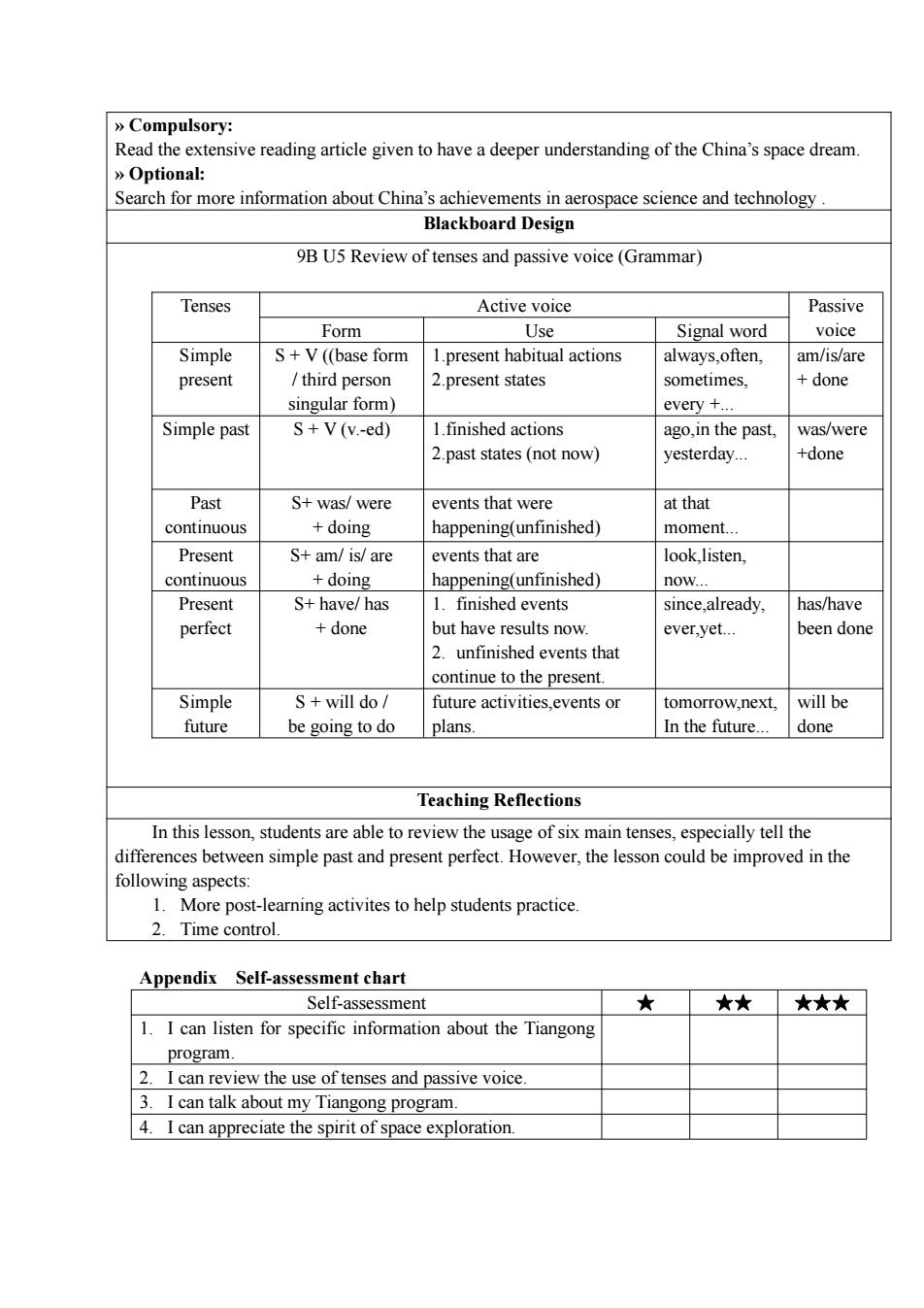正在加载图片...

》Compulsory: Read the extensive reading article given to have a deeper understanding of the China's space dream. >Optional: Search for more information about China's achievements in aerospace science and technology. Blackboard Design 9B U5 Review of tenses and passive voice(Grammar) Tenses Active voice Passive Form Use Signal word voice Simple S+V((base form 1.present habitual actions always,often, am/is/are present /third person 2.present states sometimes, +done singular form) every +.. Simple past S+V(v.-ed) 1.finished actions ago,in the past, was/were 2.past states(not now) yesterday. +done Past S+was/were events that were at that continuous +doing happening(unfinished) moment... Present S+am/is/are events that are look,listen, continuous +doing happening(unfinished) now... Present S+have/has 1.finished events since,already, has/have perfect +done but have results now. ever,yet... been done 2.unfinished events that continue to the present. Simple S+will do/ future activities,events or tomorrow,next, will be future be going to do plans. In the future... done Teaching Reflections In this lesson,students are able to review the usage of six main tenses,especially tell the differences between simple past and present perfect.However,the lesson could be improved in the following aspects: 1.More post-learning activites to help students practice. 2.Time control. Appendix Self-assessment chart Self-assessment ★ ★★ ★★★ 1.I can listen for specific information about the Tiangong program. 2.I can review the use of tenses and passive voice. 3.I can talk about my Tiangong program. 4.I can appreciate the spirit of space exploration.» Compulsory: Read the extensive reading article given to have a deeper understanding of the China’s space dream. » Optional: Search for more information about China’s achievements in aerospace science and technology . Blackboard Design 9B U5 Review of tenses and passive voice (Grammar) Tenses Active voice Passive Form Use Signal word voice Simple present S + V ((base form / third person singular form) 1.present habitual actions 2.present states always,often, sometimes, every +... am/is/are + done Simple past S + V (v.-ed) 1.finished actions 2.past states (not now) ago,in the past, yesterday... was/were +done Past continuous S+ was/ were + doing events that were happening(unfinished) at that moment... Present continuous S+ am/ is/ are + doing events that are happening(unfinished) look,listen, now... Present perfect S+ have/ has + done 1. finished events but have results now. 2. unfinished events that continue to the present. since,already, ever,yet... has/have been done Simple future S + will do / be going to do future activities,events or plans. tomorrow,next, In the future... will be done Teaching Reflections In this lesson, students are able to review the usage of six main tenses, especially tell the differences between simple past and present perfect. However, the lesson could be improved in the following aspects: 1. More post-learning activites to help students practice. 2. Time control. Appendix Self-assessment chart Self-assessment ★ ★★ ★★★ 1. I can listen for specific information about the Tiangong program. 2. I can review the use of tenses and passive voice. 3. I can talk about my Tiangong program. 4. I can appreciate the spirit of space exploration